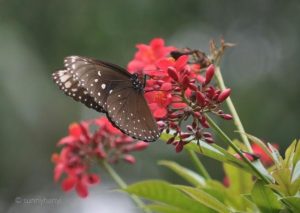I conducted a research project on the biodiversity of NParks’ Nature Ways (NWs) for several months last year. A relatively new undertaking, NWs are stretches alongside roads planted with selected tree and shrub species that aim to “facilitate the movement of animals like birds and butterflies between two green spaces”. They are strategically located to 1) link biodiversity-rich areas to urban communities, 2) serve as wildlife habitats and 3) increase residents’ accessibility to nature. These green corridors beautify our immediate surroundings and are designed to inculcate greater appreciation of Singapore’s abundant (read: remaining) biodiversity.
These short routes may seem unlikely havens, given their locations — sometimes beside major four-lane roads — that are highly disturbed by both vehicular and foot traffic, besides regular maintenance by NParks’ stuff such as pruning (a necessity to prevent shrubs from becoming overgrown and thus inciting negative public feedback). However, over the course of several months, I was pleasantly surprised to come across several common and not-so-common butterfly and bird species, including the striking Tailed Jay (below, left). While relatively common, this species frequents treetops and is rarely spotted at ground level; presumably, it was attracted to the flowers of the nearby Ixora. I also recorded one sighting of the “Moderately Rare” (Khoon, 2010) King Crow (below, right).
Some photos of my other personal favourites are in the collage below. From top to bottom, in the left column: Leopard Lacewing, Blue Glassy Tiger, Peacock Pansy; right column: Brown shrike, Common flameback, and Yellow-vented bulbul.
While these sightings indicate that certain species do utilise the NWs for forage and shelter, these are largely limited to the common ones, generalists with a wide range of suitable caterpillar host plants or food sources.
I believe that this is one way the NWs can be improved upon. Instead of further expanding the already extensive habitat of the generalist species, more focus could be placed on enhancing these locations to increase their suitability as habitat for other species — for instance, by planting a greater selection of host plants, as was done to great success at the Alexandra Hospital butterfly trail in the past.
This is also a good opportunity to introduce a new citizen science programme centred on the enhancement of biodiversity on NWs. This could be targeted at nearby residents, who will directly benefit from improvements made to these areas, and for whom the volunteering programme would be relatively accessible. It would entail the provision of caterpillars of less-common species (bred from local stock where possible) to the volunteers, who would rear and release them upon eclosion. Leaves of the host plants could be obtained from the NWs to feed the caterpillars. To maximise resident involvement, a poll could be conducted before the commencement of the project allowing residents to vote for their preferred species to care for. This being a child-friendly project, it would also help cultivate interest and curiosity for nature in the young, which is an important step towards a nation of like-minded people who care for the environment.
References
Khoon, S. K. (2010). A field guide to the butterflies of Singapore. Singapore: Ink On Paper Communications Pte. Ltd.


